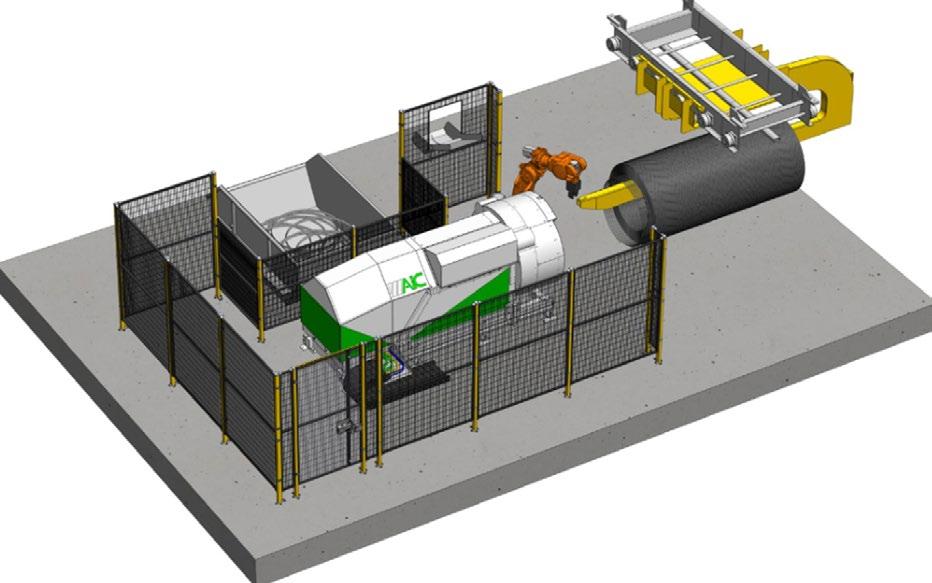
7 minute read
New autonomous mechanical system for trimming and sampling wire rod coils
edited by: J. Nylander, G. Muscarà
This paper presents a novel, patent pending, Autonomous Trimming & Sampling Station which is introduced on the market as the TRIMBOT.
INTRODUCTION: BACKGROUND
In a typical long product rolling mill, during the process of transforming a billet into a small diameter wire, the head and tail is normally of inferior quality compared with the main part of the coiled wire. There are several processrelated reasons for this such as the inability to properly cool the front-ends and uneven cooling of the wire on the cooling conveyor after the loop laying head. Regardless of the reason for this lesser quality, these parts of the wire must be removed in a process referred to as static coil trimming, followed by collecting a sample which is analysed in order to verify the intended properties of the finished product. Trimming can be performed anywhere in the rolling mill as long as it is located after the forming of the final wire. For this reason, static conventional trimming and sampling stations are typically located within the confines of the coil handling system, but there are instances where it is performed at the end of the cooling conveyor. It’s a predominantly a manual activity where at least one operator counts rings to identify, separate, cut and remove anything ranging from a short piece of a loop to several loops from the exposed end of a wire rod coil based on static instructions specifying how much to remove from each coil. This manual activity offers a very poor work-environment and is a frequent source of injuries to the operator. The actual method of counting rings also impacts negatively on both yield and product quality.
J. Nylander, G. Muscarà
Conventional trimming is always expensive to operate, without adding any particular value to the finished product. Together, the cost of manual labour, the cost associated with a reduction in yield and the cost associated with increased scrap, is significant to any long product rolling mill.
To address this, we are introducing a new, patent-pending robotic system on the market intended to completely eliminate the above-mentioned manual trimming activity based on counting rings. The new process is able to cut the wire with extreme accuracy and repeatability which reduces the amount of waste and increases the overall yield of the rolling mill. The autonomous system is also able to communicate with the rolling mill in real-time, making it possible to dynamically adjust the trimming and sampling process on each individual coil depending on the actual rolling parameters for each individual billet.
Fig.1 - Illustration of a typical TRIMBOT installation.
A New Process
As explained previously, the dominating manual trimming method using a manual ring counting process based on static instructions has inherent problems with flexibility, precision and uniformity.
Therefore, rather than calculating an approximate number of rings based on static instructions on a C-Hook, or a tilted pallet, and cutting at an approximate location along the selected loop, a more accurate method must involve actually measuring the distance along the wire. This approach provides an opportunity to measure and locate the optimal location of where to make a trim-cut with extreme accuracy and to constantly adjust this location based on the actual production parameters.
Such accurate and dynamic functionality requires a new process. Before it is possible to measure the distance with some level of accuracy, the actual end of the wire must be located.
When the end of the wire is located, the system must be able to measure along the wire until it has reached the exact position along the length of the wire where the prime quality product begins. Once the exact position is reached, the system must also be able to cut the wire at this exact position, regardless of where it occurs to be along the length of the wire. After the completed trim-cut, the same system must be able to measure, cut and remove a suitable sample of the prime quality wire.
Any optimal trimming process must therefore include the following steps:
• Locate the end of the wire.
• Measure from the end of the wire to the exact position along the wire to make the cut.
• Making a cut at the exact location.
• Measuring, cutting and collecting a sample of the wire.
In any existing straight bar rolling mill anywhere in the world, this process is very common. However, on the finished coiled wire, it has never been applied which is why the novel process is both old and tested as well as completely novel.
Fig.2 - Illustration of the principle of moving the cutting tool along the circular shaped helical wire-loop.
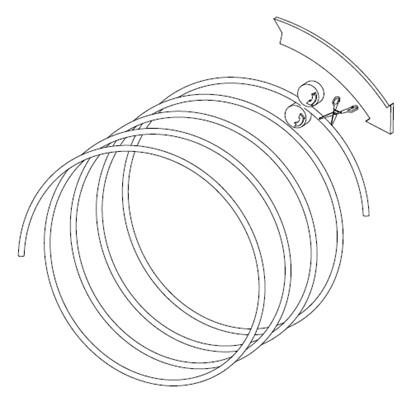
A New Type Of Machine
As established, on a straight wire, the activity of locating the end of a wire and from there measuring along the wire to find the trimming position is quite straightforward. However, in a coil, where the wire has the shape of a continuous helical multitude of wire loops, it is more challenging.
Any solution must also preserve the orderliness of the wire loops within the coil and be gentle and not scratch or damage the actual wire rod. This led to the realization that since the product that is to be processed has a circular shape, then the machine that performs the process must have the same shape and be able to move in a circular manner that follows the helical shape of the continuous coiled wire and all the vital functions and features must then be distributed along the circular shaped machine.
This resulted in a completely new machine referred to as the Ring Processing Turret (RPT).
The Ring Processing Turret is essentially a circular guide with a shape that follows the circular shape of the coiled wire. Distributed along the circular guide is an advanced pinch-roll assembly, a significant number of sensors, several guide segments and a cutting device.
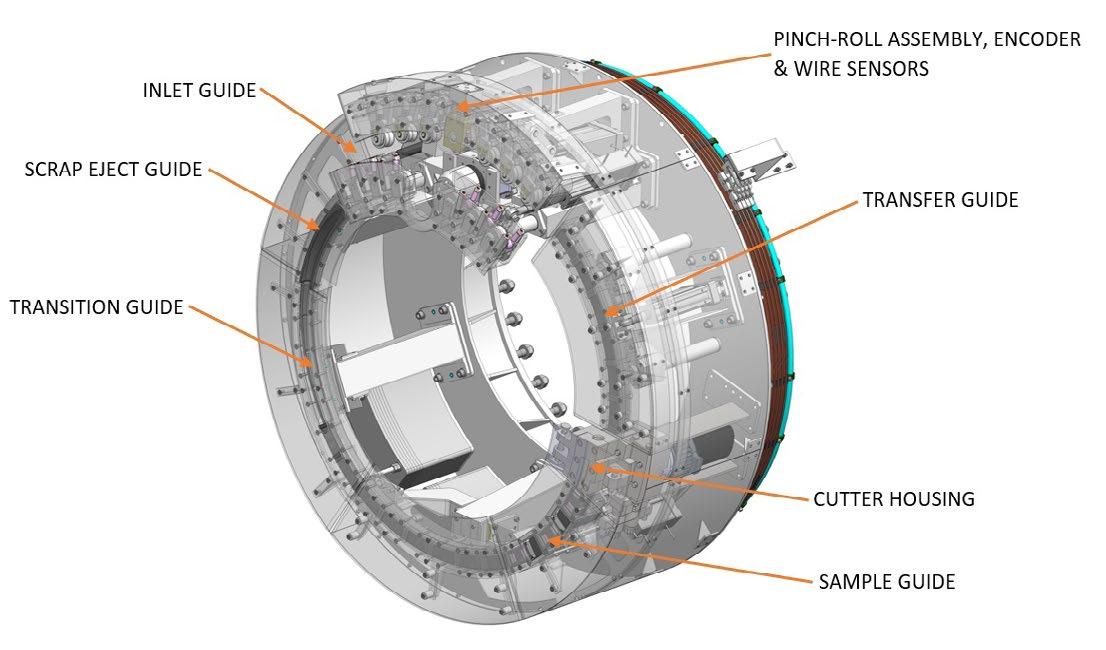
Fig.3 - Illustration of the Ring Processing Turret.
Pinch-roll assembly contains the wire receiving guide system, pinch & drive-roll, position encoder, and wire end detection sensors. The transfer guide leads the wire frontend to the cutter unit. The cutter unit cuts the wire and the sample guide retains the sample piece. The transition guide and the scrap ejector guide lead the scrap rings out to be removed after completed trimming.
Because the Ring Processing Turret performs its process relative to the exposed end of the coiled wire, and not relative to the system carrying the coil, it can perform its different process-steps regardless of how the coil is oriented. This makes it possible, for the first time to perform trimming and sampling on a vertical coil.
ROBOTIC ARM & VISION SYSTEM
To support the interaction between the coil and the Ring Processing Turret, we have designed a ring transfer and separation system, as illustrated in Fig. 4, which pulls the forwardmost rings from the exposed end of the C-hook towards the turret while also spreading them to create additional separation. An advanced vision system, as illustrated in Fig. 5 takes a snap-shot of the wire loops and makes a selection based on an advanced image analysis algorithm of which one of these wires is to be picked.
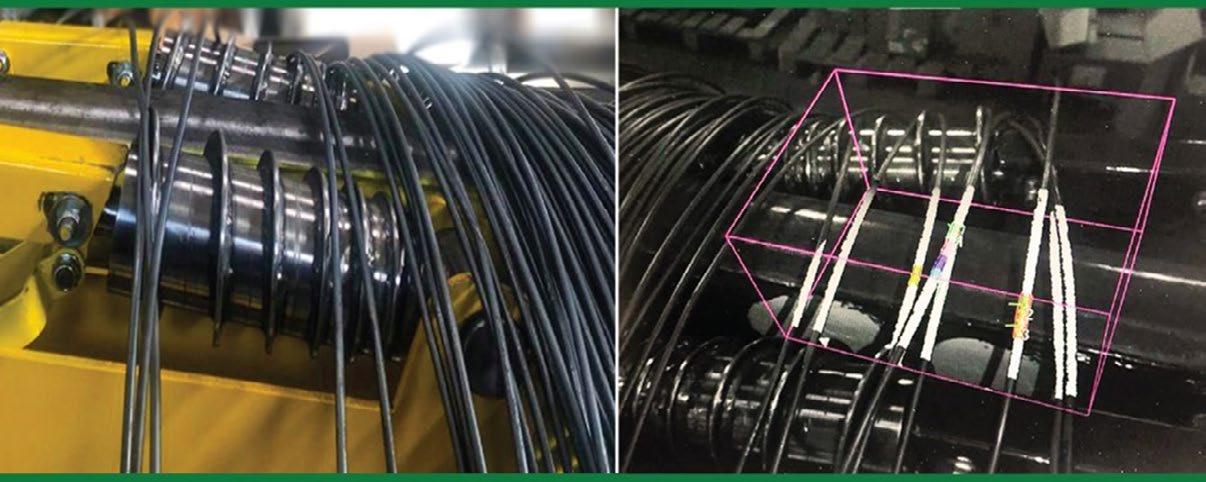
Once the selection is made, a robotic arm moves to collect the selected wire and to subsequent place the loop segment into the extended receiving guide of the ring processing turret. After the ring processing turret has performed its trimming and sampling sequence, the robotic arm moves into position to collect and discharge the trimmed rings. If a sample is required, it is collected in a separate sample guide which extends and exposes the sample to the robotic arm, which then collects the sample and places it in the sample tray, as illustrated in Fig. 6.
Fig.4 - Illustration of rings being transferred from the C-hook toward the turret.
Fig.5 - Photo of separated rings & the vision system interpretation of the same.
Fig.6 - Illustration of the robotic arm collecting a sample.
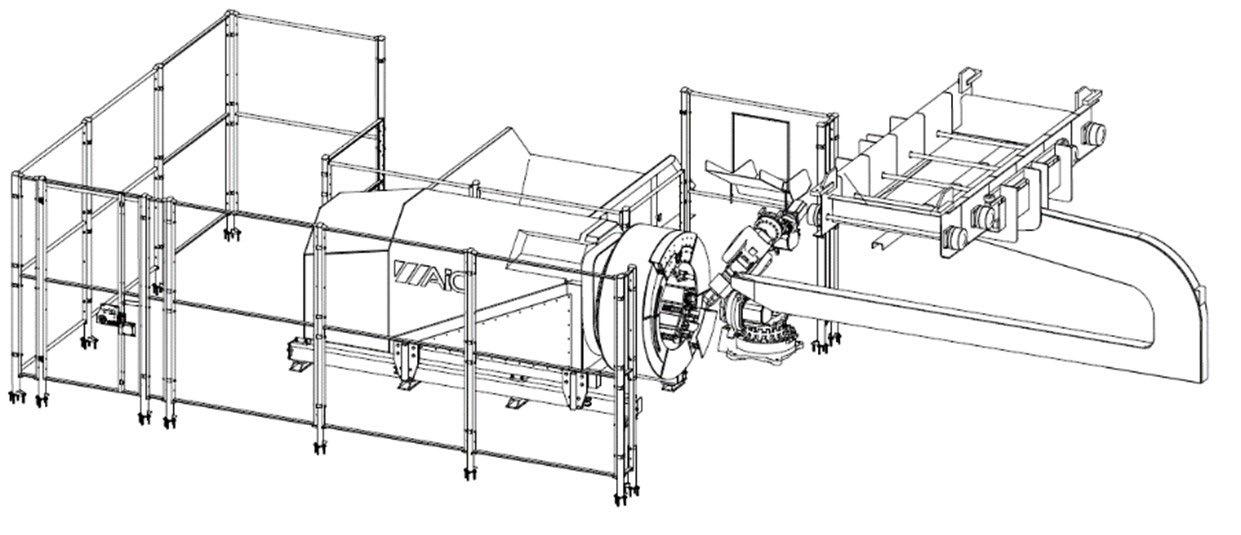
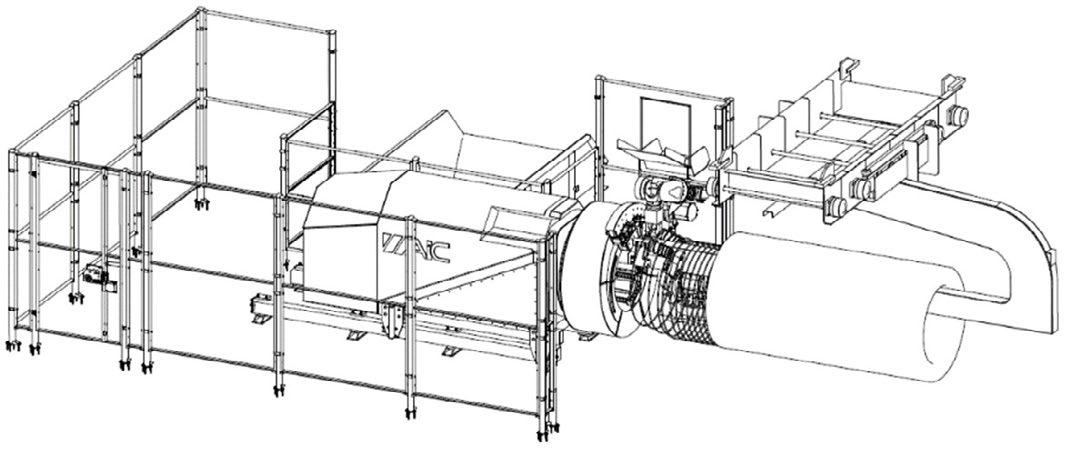
Benefits Highlights
The TRIMBOT is intentionally designed to be reasonably priced and inexpensive to install and operate. The ambition is to make the machine suitable for every existing as well as any future wire rod rolling mill in the world and also to make the machine affordable to every potential customer.
To make this possible, the TRIMBOT is designed to be installed directly in front of any existing C-hook on any existing mill floor without excavation or pouring of the new foundation. The system is very compact and while the actual TRIMBOT equipment only requires approximately 10 m2 of floor space, a safe work area with both sample and scrap collection, will require 25 to 30 m2 depending on the final configuration. It is also completely electrical, which eliminates any risk of hydraulic oil contamination from leaking hoses, pipes or connections.
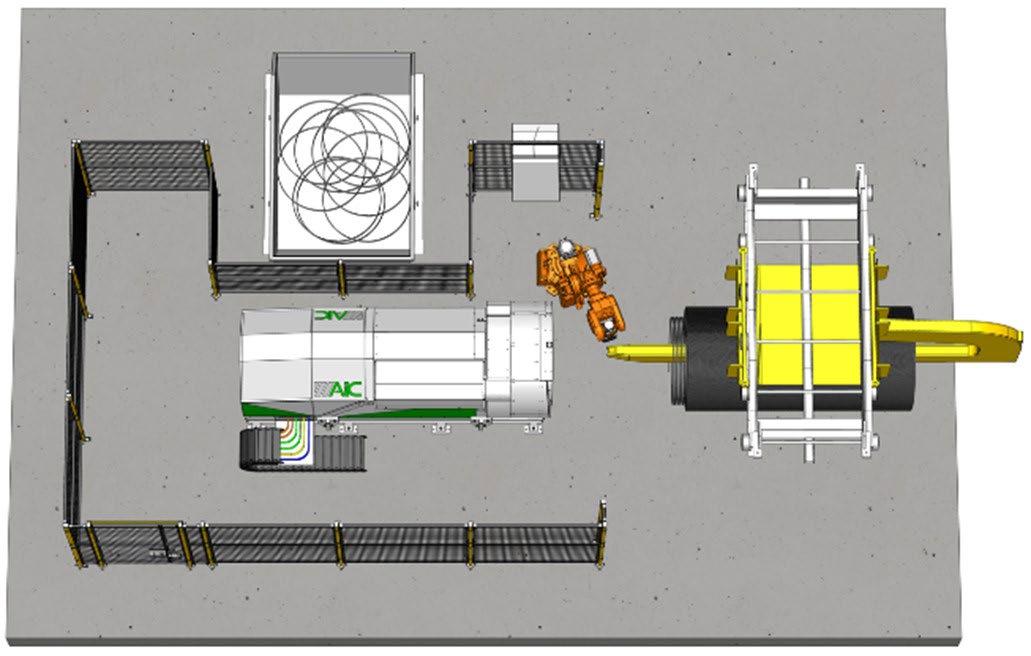
The design is also such that parts that are subject to wear are easy to access and simple to replace. The entire system is also designed to fit into a standard 20” covered shipping container and the weight is less than 5 tons which makes it easy to handle on most sites with existing cranes.
The system is meticulously tested under realistic conditions prior to being prepared for shipping to its final destination. Upon arrival at the site, it can be installed and commissioned within hours and reach full capacity within a few days.
The ambition has been to create a system that can pay for itself in 12 to 24 months depending on production rate and product mix. The savings would in part originate from the reduction in wages and benefits, but the most significant savings will originate from increased yield and the reduction of scrap produced. For any normal rolling mill, the yield will increase between 0,15 and 0,30 % and the scrap will be reduced by the same amount.
The TRIMBOT process also makes it possible to perform dynamic trimming. This means that the actual trimming location is allowed to change from one coil to the next, depending on the actual rolling conditions for each coil.
Conclusions
The completely electrical TRIMBOT is designed to fit and operate in almost any existing coil handling system with minimum disturbance to the existing site. It is primarily designed to replace any existing manual ring counting trimming activity, but its value to the rolling mill extends beyond only replacing the human operators in this area.
It offers a level of trimming accuracy that isn’t possible with a manual trimming method. A manual “ring counting” trimming has an accuracy of +/- one or two rings while the TRIMBOT makes it possible to reach a trimming accuracy of +/- 5 mm under certain conditions. This represents an incredible improvement in accuracy, and with this level of accuracy, it becomes relevant to adjust the actual trimming position based on the dynamic variations in the rolling process for each individual coil.






